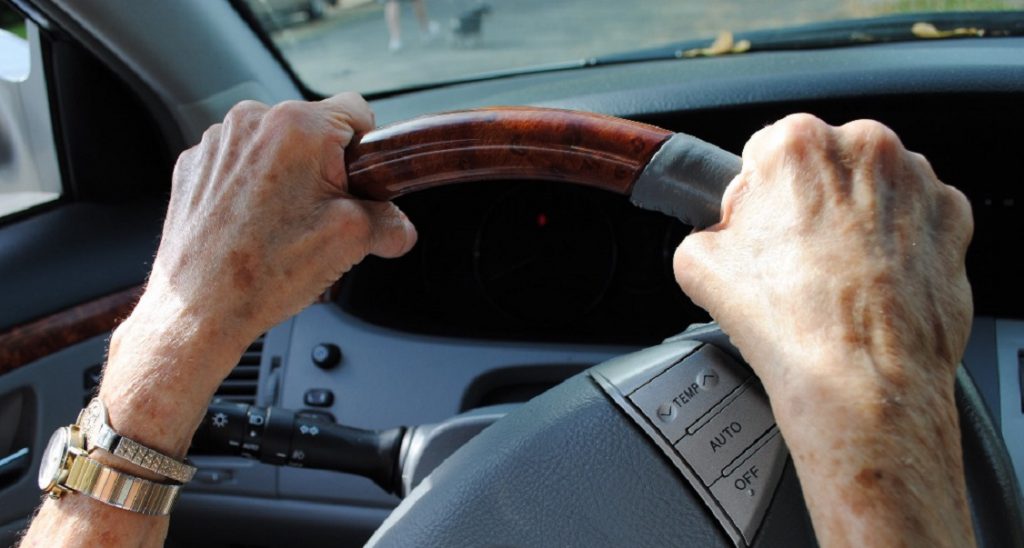Parking lot tragedies
Why do they involve older drivers and how can we prevent them?
 Parking lots can often be places of chaos, confusion and, occasionally, tragedy. Although complex in nature, there are some common factors that consistently show themselves in these types of crashes. Here are four reasons these tragedies occur and why older drivers are involved in so many parking lot crashes, particularly in the US:
Parking lots can often be places of chaos, confusion and, occasionally, tragedy. Although complex in nature, there are some common factors that consistently show themselves in these types of crashes. Here are four reasons these tragedies occur and why older drivers are involved in so many parking lot crashes, particularly in the US:
1) Pedal misapplication – In its simplest terms, pedal misapplication is nothing more than “confusing the gas pedal for the brake pedal”. The US’ National Highway Traffic Safety Administration (NHTSA) reports that in crashes involving pedal application errors, there is significant over-involvement by the youngest (age 16 to 20) and oldest (76 years of age and older) drivers.
The term “pedal application error” gained popularity after the 2003 crash in Santa Monica, California, US, when an 86-year-old George Weller pressed the accelerator instead of the brake, launching his Buick into a crowd of shoppers at an outdoor market, and killed 10 pedestrians and injured 63 others. A subsequent investigation by the US’ National Transportation Safety Board (NTSB) revealed that this was caused by the driver’s “inadvertent acceleration when he intended to brake”.
Although many possible explanations exist for every incident of pedal misapplication, declines in an older driver’s physical abilities (neuropathy, etc) as well as declines in cognitive functioning (dementia, etc) are prominent contributing factors.
2) Driver inattention or distractions – In Oklahoma City, US, a three-year-old child was struck and killed in a McDonald’s parking lot by a driver that was reportedly “distracted” by another vehicle.
As we age, we can experience more difficulty in dividing our attention among multiple tasks and in switching rapidly from one task to another. Difficulty in task management (declines in executive functioning) can be especially dangerous when manoeuvring a vehicle through a busy or poorly designed parking lot. Monitoring a GPS or vehicle navigation system, tuning the radio or even listening to conversations among passengers can prove most disruptive.
Parking lots are very busy places and they can be rather stressful. Dodging near misses, getting cut off, searching for that perfect parking spot, avoiding run-away shopping carts (and children!) and the like can quickly task even the sharpest drivers. An older driver’s ability to keep distractions to a minimum is paramount to his or her safety, as well as to the safety of other parking lot users.
By their very nature, parking lots are a haven of outside distractions. In addition to those “naturally occurring” distractions, NHTSA confirms what we already know that driver distraction from secondary (in-vehicle) sources is increasingly recognised as a significant cause of injuries and fatalities. Listening to the radio or carrying on an in-depth conversation with your passenger only serves to erode your ability to focus on the naturally-occurring distractions that a parking lot presents.
3) Backing errors caused by strength and flexibility declines – As we age, it is not uncommon to lose certain physical attributes that are important for safe driving, particularly in our strength, coordination, range of motion, flexibility and reaction time. All of these attributes contribute to the ability of an older driver to remain a safe driver.
WebMD reports that from the time you are born until around the time you turn 30, your muscles grow larger and stronger. But at some point in your 30s, you begin to lose muscle mass and function. People who are physically inactive can lose as much as three to five percent of their muscle mass per decade after age 30.
Studies consistently show a positive link between an older driver’s flexibility and their driving performance. According to an article in the Hartford-Courant newspaper in the US titled “Older Drivers Benefit from Exercise”, a 74-year-old retiree explained, “It’s harder to turn around now to look for blind spots.” He said, “Backing up is a real issue too.”
The article was based on a study conducted by The Hartford Center for Mature Market Excellence and the M.I.T. Age Lab, that looked at the effects of exercise on older drivers’ strength, flexibility, coordination and range of motion. The study found that drivers who exercised for 15 to 20 minutes daily reported greater ease in turning their heads to look at the blind spots when changing lanes or backing up, compared to a group that did not exercise. The exercise group could also rotate their bodies further and were able to get in and out of their cars with greater ease, which translates to improved flexibility.
For all of us, regardless of age, it is a good practice to eliminate or at least minimise backing wherever possible.
4) Declines in vision – The natural ageing process is not always kind. In addition to a propensity to lose some of our strength and flexibility, our vision begins to change as well. Eventually we may lose our ability to distinguish details and our field of vision can begin to narrow. Obviously, declining eyesight is likely to have an adverse effect on critical driving functions.
A narrowing of our visual field makes it harder to see objects on the edge of our visual field such as signs, signals, vehicles, pedestrians and cyclists. The density of our eye’s lenses increases, making it hard to see in low-light conditions. We may have increased sensitivity to glare, making it hard to see in the presence of oncoming headlights at night or in the presence of sun glare in the daytime.
The root cause of older drivers reporting that they didn’t “see” a pedestrian in the parking lot could stem from a number of sources. Authentic vision concerns can include anything from refractive errors, age-related macular degeneration or glaucoma, to cataract, diabetic retinopathy, or a decline in peripheral vision. Consideration should also be given to the fact that 90 percent of the information we need to respond to driving cues comes through our eyes, making vision the single most important sense for safe driving.
In a project by the US’ National Safety Council (NSC) titled “Understanding the Distracted Brain”, researchers found that distracted drivers have a tendency to “look at” but not “see” objects. Distracted drivers experience what researchers call inattention blindness, similar to that of tunnel vision. According to the study, drivers are looking out the windshield, but they do not process everything in their driving environment, which significantly limits their ability to effectively monitor their surroundings, seek and identify potential hazards, and respond to unexpected situations.
 So what can the older driver do to mitigate the likelihood of being involved in a parking lot crash? Here are a few helpful tips:
So what can the older driver do to mitigate the likelihood of being involved in a parking lot crash? Here are a few helpful tips:
- Use only pull-through parking spots; don’t park in a spot that you will have to back out of!
- Take-up enjoyable activities like gardening, swimming, walking, etc to help keep you in good physical shape.
- Talk to your doctor about recommended exercises designed to maintain the flexibility and strength needed for safe driving.
- Talk to your doctor if you are experiencing any type of peripheral neuropathy, especially in your hands or feet.
- Remain vigilant and expect the unexpected (child running in front of your car, etc).
- Consider vehicle adaptations to mitigate the potential of an accident (oversized rear view mirrors to help eliminate blind spots, adjustable foot pedals, etc).
- Correctly set the outside mirrors beforehand. Consider adding blind spot mirrors to the side mirrors.
- When possible, park away from other cars, and don’t park in a spot that you will have to back out of!
- Do not drive if you are taking medications that might impair your judgment, vision, reflexes, etc.
- Take advantage of new technology such as parking assist features, collision avoidance systems and rear view cameras (which can be added after-market).
- Remain alert to cars reversing by watching for backup lights. If a car begins backing up, get out of the way or make sure the driver can see you.
- Practice good defensive driving skills.
- Shop on lower volume days, which equates to less parking lot congestion.
- Wear appropriate shoes for driving and make sure your floor mat is positioned properly.
- Keep the windows clear and void of obstructions.
- Tap your horn (similar to a back-up warning system found on construction vehicles) before backing.
- Eliminate as many in-vehicle distractions as possible (turn the radio off, discontinue conversations and remember to leave any pets at home).
Parking lot crashes involving older drivers can be caused by any number of contributing factor(s), including but not limited to driver inattention, distractions from either inside or outside of the vehicle, declining muscle mass, medication issues, pedal misapplication, mental fitness and declines in cognition, medical emergencies, pre-existing medical conditions, declining vision, fatigue, poor flexibility, unfamiliarity with the vehicle, improper seat or mirror positioning, improper blood sugar levels, or in some very rare cases … just plain carelessness.
** This article by US’ Keeping Us Safe has been adapted with permission. Keeping Us Safe is an organisation that provides practical, real-life solutions to older drivers and their families including a self-assessment programme for older drivers.
(** PHOTO CREDITS: Keeping Us Safe)

0 Comments